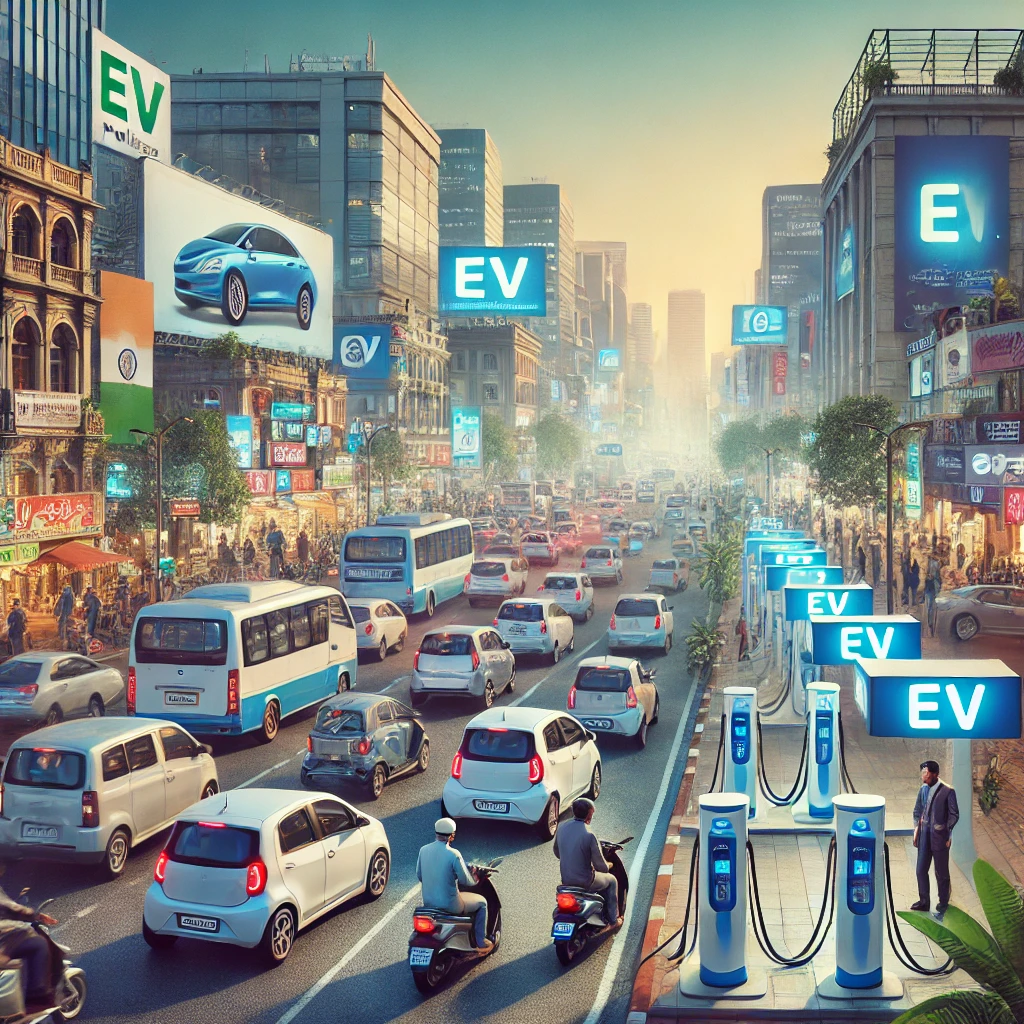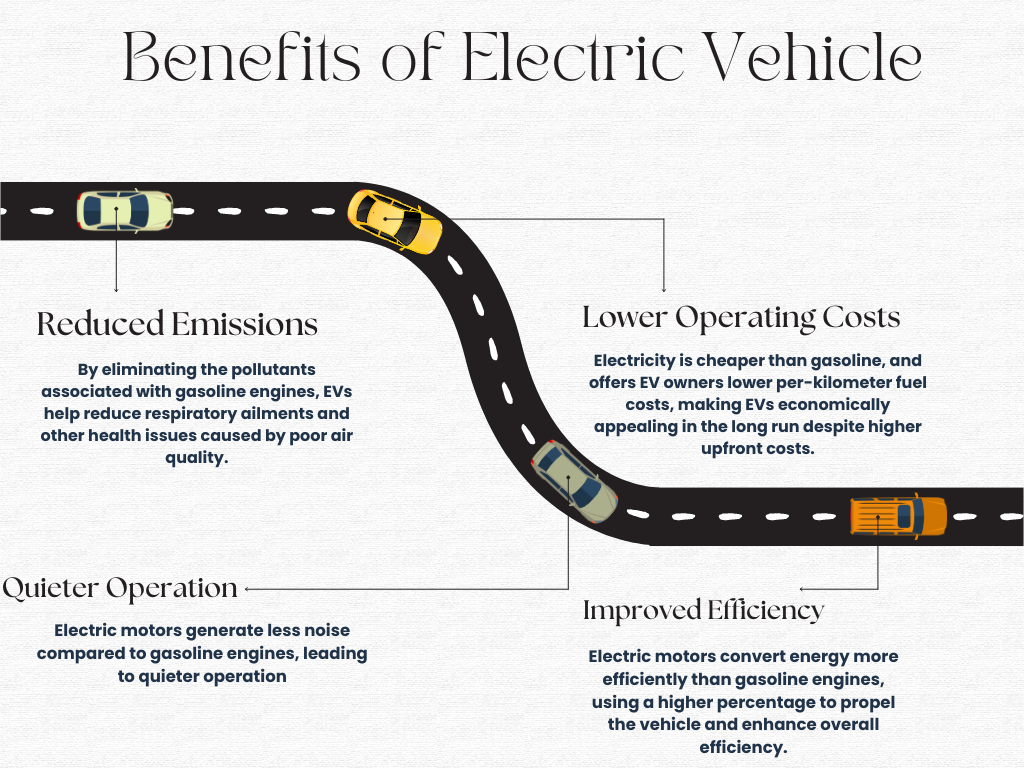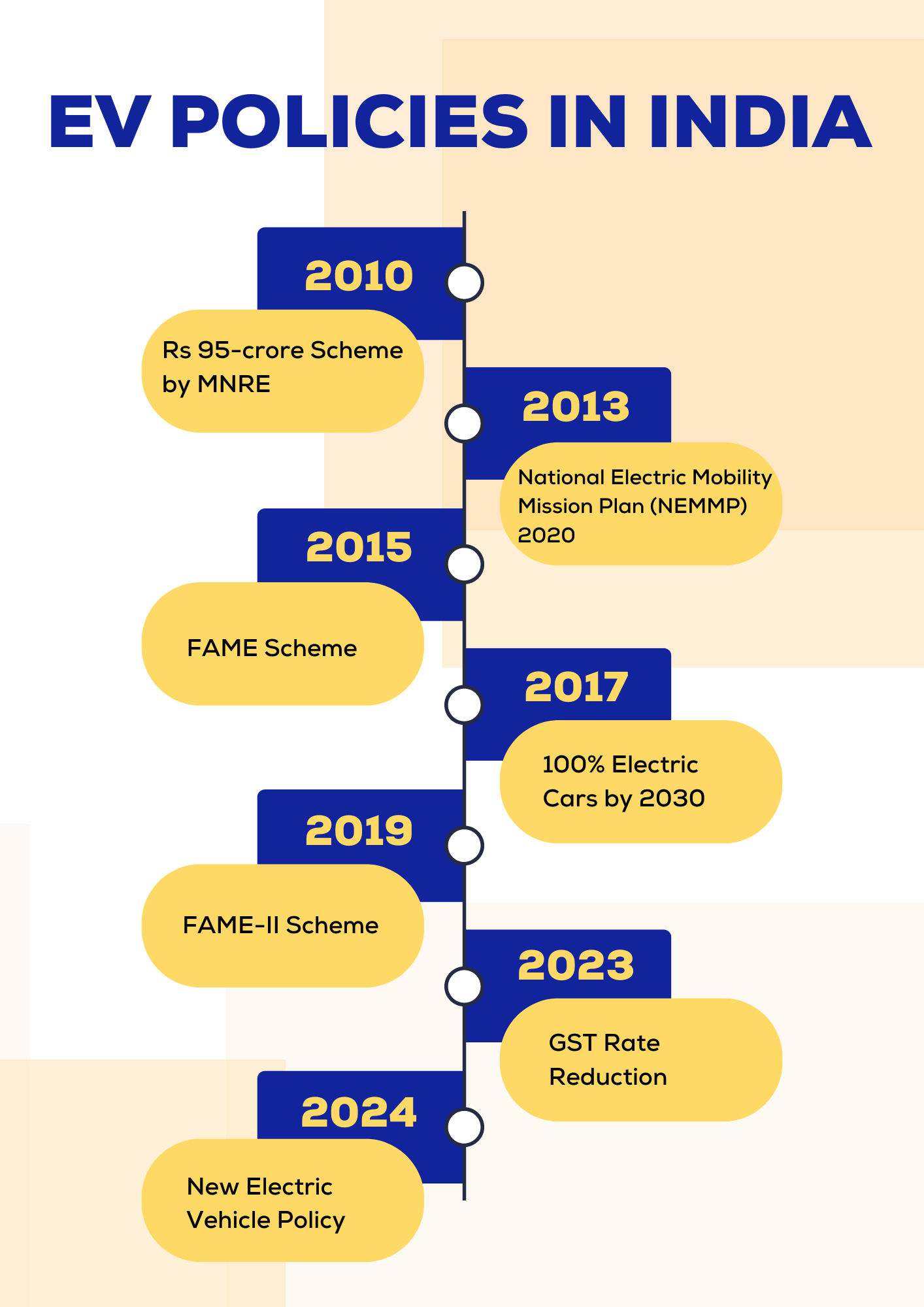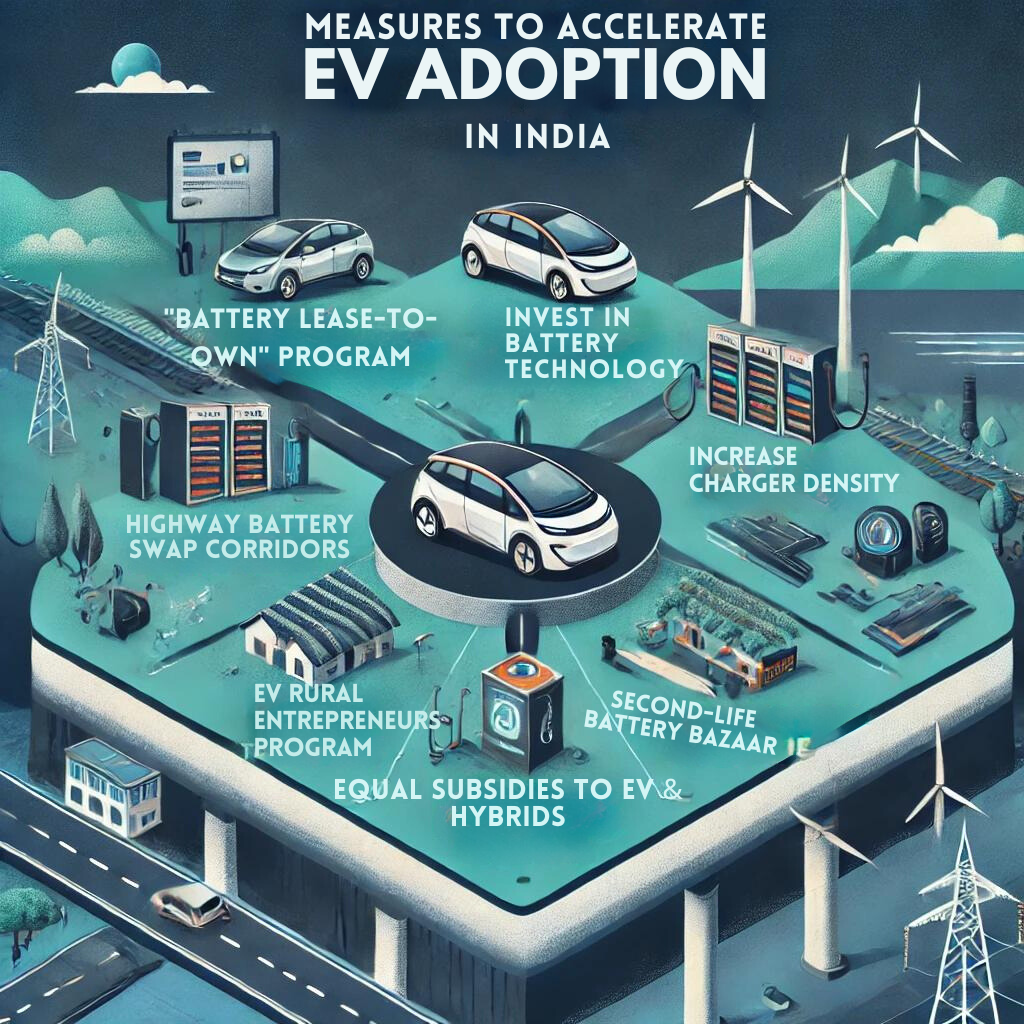India’s debate over electric vehicle (EVs) involves complex considerations of emissions, cost, and policy. While EVs are praised for their zero tailpipe emissions, experts note that India’s coal-based electricity generation could result in higher lifecycle emissions for EVs compared to internal combustion engine (ICE) vehicles or hybrids. Hybrid vehicles, with their smaller batteries and better fuel efficiency, might offer a more balanced solution for emissions reduction and cost-effectiveness. Government subsidies and evolving policies will play a crucial role in shaping the future of India’s automotive market.
Electric vehicles use one or more electric motors for propulsion, unlike traditional vehicles that use internal combustion engines. The interest in EVs has surged due to growing concerns about carbon footprints and environmental impacts. There are three main types of EVs: Battery Electric Vehicles (BEVs), Plug-in Hybrid Electric Vehicles (PHEVs), and Hybrid Electric Vehicles (HEVs).
India can learn from other countries’ success stories. Financial incentives in Europe, government support and competition in China, and innovation in the US offer valuable lessons. By adopting these strategies and optimizing government policies, India can achieve a sustainable transition to electric vehicles while balancing environmental and economic considerations.
Origin of the Article
This editorial is based on “Should not EVs and Hybrids be treated equally for government subsidies?” published in The Hindu on June 21, 2024. The article emphasizes the importance of adopting strong hybrids and electric vehicles to achieve greater emissions reductions and align with India’s climate and energy goals.
Relevancy for UPSC Students
The topic is highly relevant for UPSC aspirants as it covers key aspects of the General Studies Paper 3 syllabus, including science and technology, environmental issues, and government policies. Understanding the intricacies of EV adoption can help aspirants answer questions related to sustainable development, technological advancements, and policy-making.

Why in News
The topic of electric vehicles (EVs) is currently in the news due to ongoing debates about government subsidies and policies that affect their adoption. With India aiming to reduce emissions and achieve energy security, the discussions around lifecycle emissions and the cost-effectiveness of EVs versus hybrids are crucial. This topic is important for UPSC aspirants as it connects with previous questions related to sustainable transportation, government policies, and environmental impact, making it highly relevant for both GS Paper 2 and GS Paper 3.
What are Electric Vehicles?
Electric vehicles (EVs) are powered by electric motors instead of traditional internal combustion engines (ICEs). This propulsion mechanism relies on electricity stored in batteries, making EVs an attractive alternative for reducing carbon emissions and environmental impact. The growing interest in EVs stems from the need to address climate change and reduce dependency on fossil fuels.
Types of Electric Vehicles
Battery Electric Vehicles (BEVs) rely solely on battery power for propulsion and produce zero tailpipe emissions. Plug-in Hybrid Electric Vehicles (PHEVs) combine an electric motor with a gasoline engine, allowing for external charging and battery-powered operation for short distances. Hybrid Electric Vehicles (HEVs) use both an electric motor and a gasoline engine, with the battery charged through regenerative braking and the engine.
Benefits of EVs
Electric vehicles offer numerous benefits, including reduced emissions, lower operating costs, quieter operation, and improved efficiency. These advantages make EVs a compelling choice for both individual consumers and policymakers aiming to promote sustainable transportation.

Reduced Emissions
EVs produce zero tailpipe emissions, which significantly contribute to cleaner air and improved public health. By eliminating the pollutants associated with gasoline engines, EVs help reduce respiratory ailments and other health issues caused by poor air quality.
Lower Operating Costs
Electricity is generally cheaper than gasoline, resulting in lower fuel costs per kilometer for EV owners. This economic advantage makes EVs more appealing in the long run, despite their higher initial purchase price.
Quieter Operation
Electric motors generate significantly less noise compared to gasoline engines, leading to quieter operation. This reduction in noise pollution is particularly beneficial in urban areas, where traffic noise is a significant concern.
Improved Efficiency
Electric motors boast higher energy conversion efficiency compared to gasoline engines. This means that a greater percentage of the energy from the battery is used to propel the vehicle, enhancing overall vehicle efficiency.
EV Policies in India
India’s journey towards electric vehicle adoption has been marked by various policies and initiatives aimed at promoting EV usage. These measures reflect the country’s commitment to reducing vehicular pollution and enhancing energy security.
2010: Rs 95-crore Scheme by MNRE
The Ministry of New and Renewable Energy (MNRE) launched a Rs 95-crore scheme in 2010, providing up to 20% incentives on ex-factory prices to encourage EV adoption. This initial push aimed to make EVs more affordable for consumers.
2013: National Electric Mobility Mission Plan (NEMMP) 2020
In 2013, the National Electric Mobility Mission Plan (NEMMP) 2020 was introduced to boost EV adoption, address energy security, and reduce vehicular pollution. However, the plan largely remained unimplemented.
2015: FAME Scheme
The Union Budget of 2015 announced the Faster Adoption and Manufacturing of Hybrid and Electric Vehicles (FAME) scheme, with a Rs 75 crore outlay to incentivize clean-fuel technology cars. The scheme aimed to achieve 7 million EVs by 2020.
2017: 100% Electric Cars by 2030
The Indian Transport Ministry initially aimed for 100% electric cars by 2030. However, the plan was later scaled down to 30% after considering industry concerns about feasibility.
2019: FAME-II Scheme
In 2019, the Union Cabinet approved the Rs 10,000-crore FAME-II scheme to accelerate EV adoption. The scheme provided upfront purchase incentives and support for charging infrastructure development.
2023: GST Rate Reduction
The 36th GST Council Meeting in 2023 decided to reduce the GST rate on electric vehicles from 12% to 5% and on chargers or charge stations from 18% to 5%. This move aimed to boost the EV market by making them more affordable.
2024: New Electric Vehicle Policy
In 2024, the Centre proposed a new electric vehicle policy that is currently under consultation. This policy aims to further streamline and enhance the adoption of EVs across the country.

Environmental Benefits of EV Adoption
Adopting electric vehicles can bring substantial environmental benefits, particularly in reducing air and noise pollution and improving operational efficiency. These advantages make EVs a critical component of sustainable urban development.
Reducing Air Pollution
Vehicular air pollution is a significant health issue in India, responsible for various respiratory diseases. EVs can mitigate this problem by reducing harmful emissions, contributing to better air quality and public health.
Reducing Noise Pollution
Noise pollution is a major concern in urbanized regions of India. EVs contribute to lowering noise levels as they lack the mechanical noise generated by ICE vehicles, providing a quieter urban environment.
Improving Operational Efficiency
EVs offer improved fuel efficiency compared to petrol or diesel cars, converting a higher percentage of energy into usable power. This enhanced energy optimization leads to reduced operational costs and increased demand for EVs.
Read how AI is transforming medical research.
Major Challenges Related to Electric Vehicle Adoption in India
Despite the benefits, several challenges hinder the widespread adoption of electric vehicles in India. Addressing these issues is crucial for realizing the full potential of EVs.
High Cost of EVs
The high upfront cost of EVs compared to ICE vehicles is a significant barrier. Government subsidies can help mitigate this issue, but more comprehensive measures are needed to make EVs financially accessible to a broader audience.
Limited Charging Infrastructure
India’s charging infrastructure is still developing, leading to “range anxiety” among potential EV owners. Expanding the network of charging stations is essential to alleviate this concern and encourage EV adoption.
Lack of Robust Local Battery Manufacturing Ecosystem
India relies heavily on imported Lithium-ion batteries, which are crucial for EVs. Developing a local battery manufacturing ecosystem is vital to reduce dependency on imports and lower costs.
Grid Dependence and Emissions
India’s electricity grid is primarily coal-reliant, which affects the overall emissions of EVs. To maximize the environmental benefits of EVs, increasing the share of renewable energy in the grid is necessary.
Skill Gap in EV Maintenance
Maintaining EVs requires specialized skills that the current Indian automotive workforce lacks. Training programs and educational initiatives are needed to bridge this skill gap.
Apprehensions of Adaptation for Indian Conditions
Extreme temperatures in India can impact EV performance. Addressing consumer concerns about the reliability of EVs in diverse climatic conditions is crucial for their widespread acceptance.
Recycling and Sustainability Concerns
The recycling of Lithium-ion batteries poses significant challenges due to the presence of rare earth elements. Establishing a robust recycling system is essential for sustainable EV adoption.
Range Anxiety
Range anxiety, the fear of running out of battery charge, is a major concern for consumers. Enhancing the range of EVs and expanding the charging infrastructure can help alleviate this issue.
PESTEL Analysis
| Political: India’s government has been actively supporting the transition to EVs through policies and incentives, such as the National Electric Mobility Mission Plan, FAME schemes, and substantial funding allocations. Recent moves include reducing the GST rate on EVs and formulating a new EV policy. These governmental efforts aim to boost EV adoption by making them more economically viable and environmentally beneficial. Economic: EVs present economic benefits like lower operating costs due to cheaper electricity compared to gasoline. However, high initial costs and dependency on imported batteries make EVs less accessible for the average consumer. Financial incentives and subsidies are crucial to overcoming these economic barriers. Social: The shift to EVs can significantly enhance public health by reducing air and noise pollution, two major urban challenges. However, the social acceptance of EVs is hindered by range anxiety and a lack of familiarity with the technology, indicating a need for widespread public education and awareness campaigns. Technological: Technological advancements in battery efficiency and charging infrastructure are vital for EV adoption. Challenges remain in battery life, performance under extreme temperatures, and recycling concerns. India needs to invest in research and development to create robust, sustainable battery solutions and comprehensive recycling mechanisms. Environmental: EVs offer substantial environmental benefits by reducing tailpipe emissions and improving energy efficiency. Nonetheless, the overall environmental impact is mitigated by India’s reliance on coal-based power generation for electricity, which powers the EVs. Transitioning the power grid to more renewable sources is essential for realizing the full environmental benefits of electric vehicles. Legal: Legal frameworks supporting EV adoption include incentives under various schemes and policies. However, there’s a need for stringent regulations regarding battery disposal and recycling to manage the environmental footprint effectively. |
Measures to Accelerate EV Adoption in India
Various measures can be adopted to accelerate the adoption of electric vehicles in India. These initiatives will help overcome existing challenges and promote a sustainable transition to EVs.
“Battery Lease-to-Own” Program
Implementing a government-backed “Battery Lease-to-Own” program can reduce the initial cost of EVs. This scheme allows consumers to lease the battery, significantly lowering the purchase price and making EVs more affordable.
Invest in Battery Technology
Innovations in battery technology are crucial for improving EV propulsion and travel distances. Investing in research and development can lead to more efficient and cost-effective batteries.
Increase Charger Density
Increasing the number of EV charging stations is vital to encourage adoption. Expanding the charging network in urban and rural areas will address range anxiety and promote EV usage.
“EV Rural Entrepreneurs” Program
Enabling rural individuals to set up small-scale EV charging stations can create new economic opportunities. Providing micro-loans and technical support will help establish a robust rural charging network.
Highway Battery Swap Corridors
Establishing standardized battery swap stations along major highways can facilitate long-distance travel for EVs. This initiative will reduce wait times and enhance the convenience of EV usage.
Equal Subsidies to EVs and Hybrids
Treating EVs and hybrids equally for government subsidies ensures efficient resource use. This approach supports a balanced transition to greener transportation technologies.
Second-Life Battery Bazaar
Creating a marketplace for used batteries suitable for repurposing can promote sustainability. This initiative will reduce electronic waste and support a circular economy for EVs.

Lessons from Other Countries’ Success
India can learn valuable lessons from the successful adoption of EVs in other countries. These insights can help shape effective policies and strategies for promoting EV usage.
Europe (EU, EFTA, UK)
Financial incentives in Europe have significantly increased EV adoption. Implementing similar policies in India can accelerate EV penetration and promote sustainable transportation.
China
China’s government support and domestic competition have driven down EV prices, making them more accessible. Encouraging competition and continued government support can lead to a thriving EV industry in India.
The US
The US’s government investments and private sector innovation have shaped its substantial EV market. India can foster innovation and strategically phase out government funding to support a sustainable EV ecosystem.
Conclusion
India’s electric vehicle journey is at a pivotal juncture, balancing emissions, costs, and policy intricacies. As UPSC aspirants, it’s crucial to understand that the future of EVs hinges on dynamic policies, innovative technology, and robust infrastructure. Embracing these aspects will not only propel India’s green transportation goals but also contribute to broader climate and energy security objectives.
| UPSC Civil Services Examination, Previous Year Questions (PYQs) Mains Q. Discuss the major challenges associated with the adoption of electric vehicles in India. What measures can be taken to accelerate EV adoption in India? (GS-III, 2022) Q. The Government of India has introduced several schemes and policies to promote electric vehicles (EVs), such as the National Electric Mobility Mission Plan (NEMMP) 2020 and the FAME scheme. Critically examine the effectiveness of these initiatives. What further steps can be taken to enhance the adoption of EVs in India? |

